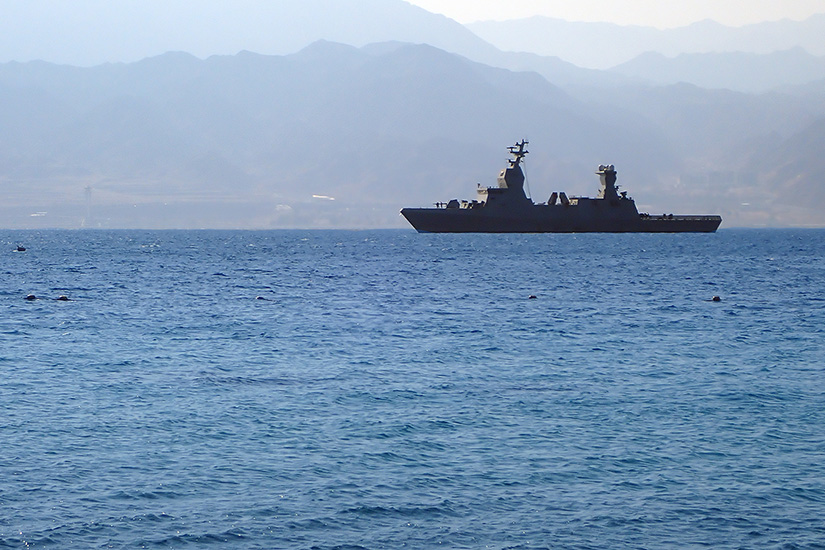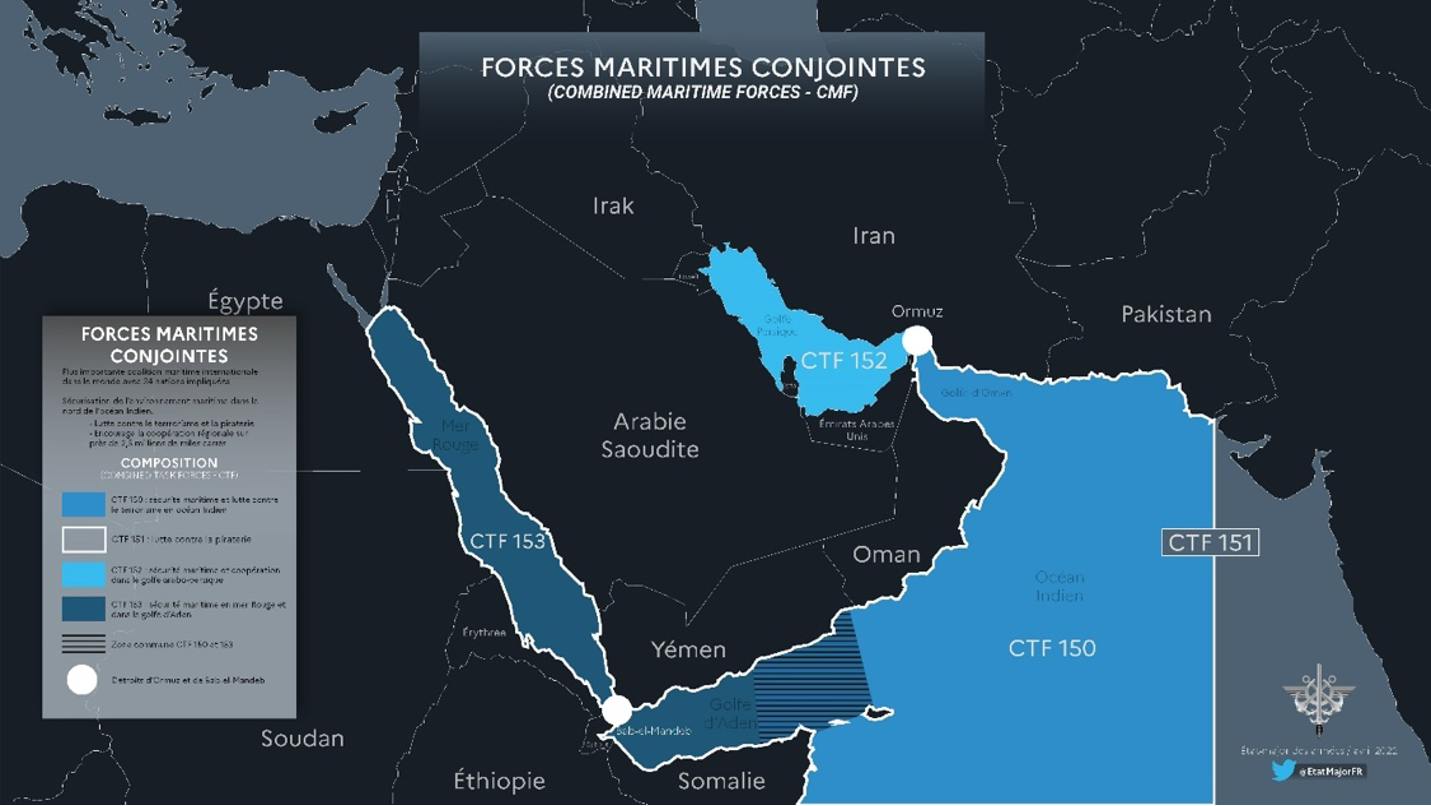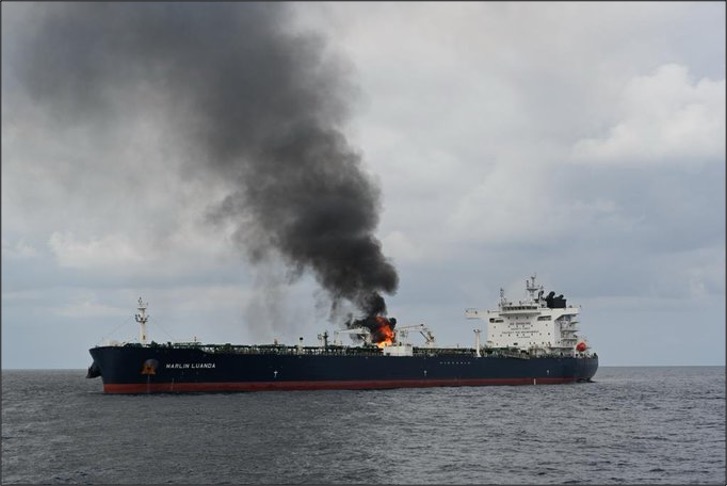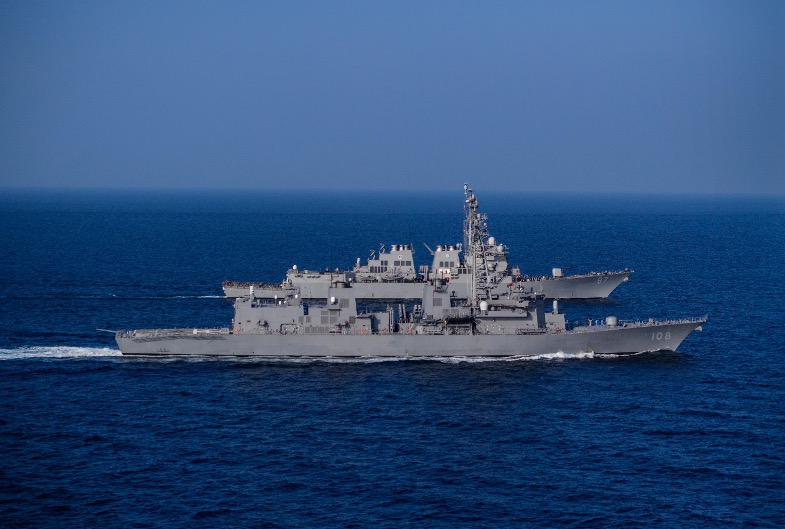Introduction
The Red Sea and the Gulf of Aden, where attacks on merchant ships by the Houthis are continuing, is transforming into a third battlefield following on from Ukraine and Gaza.[1] Despite that, the current situation is that detailed information is not being communicated sufficiently. Several reasons for this can be considered. Firstly, in conflicts on land the media can go to the front line to gather and transmit information themselves. On the other hand, in conflicts at sea, normally the media cannot go to the front line. As a result of that, transmission of information at the front line is limited to press conferences and press releases by governments and militaries, which face restrictions regarding the content they publish, so the information tends to be limited to the core factual matters. Furthermore, on land there is a greater amount of information because many issues of great interest to the international community arise, namely humanitarian issues such as harm to innocent civilians. However, the sea is separated from the general sphere of social life, so events which draw great interest from the international community such as those pertaining to humanitarian issues are limited. These facts seem to lead to a lack of information. However, if we join the fragmentary information together, the connections with the armed conflicts in Ukraine and Gaza come into view.
In this paper, firstly this author will systematically compile the fragmentary information from the United States (U.S.) Department of Defense, the United Kingdom (U.K.) Ministry of Defence, the U.S. Navy, and others as much as possible, and summarize the situation occurring on the ground. After that, this author will consider the trends going forward and how the international community should respond.

1.Combined Maritime Forces (CMF)
1) Activities by the CMF
The CMF is under the umbrella of the U.S. Central Command (CENTCOM), is commanded organizationally by a U.S. Navy Vice Admiral who also serves as Commander, U.S. Naval Forces Central Command (NAVCENT) and Commander, 5th Fleet. Although the CMF is a multilateral coalition organization, the participating countries are not under its unified command but rather under the command of their own country.
Figure 1: Combined Task Force areas of operation

The CMF is comprised of five Combined Task Forces (CTFs) and the commander of each CTF is rotated around each country.
Operation Prosperity Guardian (OPG)[2] under the umbrella of CTF 153 is engaged in guarding merchant ships from the Houthi attacks, which use ballistic and cruise missiles, drones, and other weapons and are repeated daily, but in addition the CTF 151 counter-piracy unit established in January 2009 is continuing to fight piracy in the local waters with good results, and Japan is also participating.
Moreover, CTF 150,[3] which is in charge of Maritime Security Operations (MSOs) outside the Arabian Gulf, has been cracking down on criminal organizations and terrorist organizations since before the attacks by the Houthis on merchant ships. It not only boards suspicious ships to seize drugs but also boards and seizes suspicious ships transporting weapons and ammunition from Iran to the Houthis on the grounds that they are in violation of United Nations Security Council Resolution 2216[4] and seizes the weapons and other items loaded on the ships. [5] The U.S. Department of Justice filed a forfeiture action regarding the weapons and ammunition, among others, seized here [6] and transferred those whose confiscation was permitted in court to the Ukrainian armed forces. [7] At a time when the military aid package for Ukraine was stalled, this hidden military aid was evaluated as being useful for the defense of Ukraine, [8] so the connection between the attacks on merchant ships by the Houthis and Ukraine comes into view here.
According to the legal complaint, “U.S. Naval Forces Central Command seized the weapons from four interdictions of stateless dhow vessels: two from 2021 and two from 2023. These interdictions led to the discovery and seizure of four large caches of conventional weapons, including long arms and anti-tank missiles, and related munitions – all of which were determined to be primarily of either Iranian, Chinese, or Russian origin.”[9]

Source: “U.S. Navy Seizes 1,400 Assault Rifles During Illicit Weapons Interdiction,” NAVCENT Public Affairs, News Stories, December 22, 2021.
2) Action as exercise of the right of self-defense
On the ground, in addition to these CMF activities in international waters and airspace, on the high seas and in the skies above them, the U.S. and the U.K. carried out an aerial bombing of the military facilities of the Houthis inside the territory of Yemen for the first time on January 11, 2024 (January 12 local time).[10] The U.S. and the U.K. each reported this aerial bombing to the Security Council in accordance with the provisions of Article 51 of the Charter of the United Nations as the exercise of the individual right of self-defense based on that article,[11] while asserting that “We’re not interested in a war with Yemen. We’re not interested in a conflict of any kind here”[12] and emphasizing the fact that “These strikes have no association with and are separate from Operation Prosperity Guardian.”[13] Therefore, this aerial bombing was carried out by the U.S. 5th Fleet and the U.K. Royal Air Force, not the CMF, and Australia, Bahrain, Canada, and the Netherlands provided non-operational support.[14] Furthermore, with respect to these strikes, the U.S., the U.K., the countries supporting the strikes, and Denmark, Germany, New Zealand, and the Republic of Korea issued a joint statement saying that the “joint strikes” on the territory of Yemen in response to continued illegal attacks by the Houthis were in “accordance with the inherent right of individual and collective self-defense, consistent with the UN Charter,” and that “These precision strikes were intended to disrupt and degrade the capabilities the Houthis use to threaten global trade and the lives of international mariners in one of the world’s most critical waterways.”[15] The attacks by the Houthis on merchant ships did not stop even in June, so the strikes inside the territory of Yemen by both the U.S. and the U.K. are being continued currently.[16]

2. European Union Naval Force (EUNAVFOR)
Initially France, Italy, Spain, and other countries declared their participation in the U.S.-led OPG. However, they opposed the strikes on the territory of Yemen by the U.S. and the U.K. on January 11, reversed their decision to participate in the OPG, and formed the EU’s own Operation Aspides (OA) under EUNAVFOR in order to clearly demonstrate their attitude of distinguishing themselves from the actions of the U.S. and the U.K.[17] In order to make this posture clear, when founding OA, the EU emphasized that OA does not envision any participation in strikes against the Houthis and will only operate at sea with an escort, patrol, surveillance, and intercept mandate.[18]
OA received initial funding from Belgium, Denmark, France, Germany, Greece, Italy, and Spain, and four frigates have been given an escort mandate, one each from France, Germany, Italy, and Greece.[19] Although OA is an escort unit formed due to opposition to the U.S. and the U.K., coordination and cooperation with the OPG is being maintained.
3. Cooperation among maritime units
A specific mandate has been designated for each CTF, but they also act in cooperation with each other to take action in areas outside that mandate. For example, on November 26, 2023, the destroyer USS Mason assigned to Task Force (TF)-55 and P8 patrol and reconnaissance aircraft from TF-57 under the command of NAVCENT[20] and the Japan Maritime Self-Defense Force (JMSDF) destroyer JS Akebono, JMSDF P-3C maritime surveillance aircraft, and Republic of Korea Navy destroyer ROKS Yang Man-chun from the CTF 151 unit cooperated with the CTF 151 Group to take action in response to reports that the M/V Central Park had been seized while transiting international waters. Subsequently, working in coordination with NAVCENT, the aircraft kept a watchful eye on events until surface units could converge on Central Park’s location. After several hours the perpetrators, unable to gain control of the ship, abandoned the vessel and attempted to escape on their skiff but, tracking their movements, the international force cornered the skiff and the individuals surrendered to sailors from Mason and were taken into custody in accordance with international law.[21]

Source: “Fire onboard MV #MarlinLuanda brought under control,” Indian Navy Spokesperson, February 7.2024.
Furthermore, on January 26, Bermuda-owned M/V Marlin Luanda was attacked by the Houthis with an anti-ship ballistic missile, causing a major fire to break out on the ship. The USS Carney of OPG, the French Navy Frigate FS Alsace of OA, and the Indian Navy Frigate INS Visakhapatnam, which was carrying out its own independent escorting operations, cooperated to respond quickly to this situation, extinguishing the fire by providing critical firefighting material and assistance to the tanker crew, who had depleted their organic firefighting capability. There were no casualties in the attack and the tanker remains seaworthy, and has returned to its previous course.[22]
Moreover, on March 9, the U.S. and U.K. navies under OPG and the French navy under OA collaborated in response to a Houthi drone attack on the Singapore-flagged M/V Propel Fortune and U.S. destroyers by shooting down several dozen drones.[23]
The combined navy units of OPG and OA, which are engaged in the protection of merchant ships on the ground, are not acting under a unified command; they are acting under authority granted by their home country. Furthermore, there is not much difference between the authority granted to them and that granted to navy units carrying out independent escorting operations like India, so even if some coordination becomes necessary a certain degree of consistency is guaranteed in the actions of each country. The navy units of each country taking action on the ground in this way are cooperating and collaborating as necessary to engage in a response to protect merchant ships, regardless of their affiliation or their original mandate.[24]

Source: U.S. Navy, All Hans, Image Gallery; 231125-N-WJ225-2298, November 25, 2023.
Conclusion
The Houthis, who have declared their support for Hamas, say they “will continue to target vessels in the Red Sea area until Israel stops its military campaign against Hamas in the Gaza Strip”[25] and the armed retaliations between the two sides, namely the attacks on ships by the Houthis and the strikes on the Houthi military facilities by CENTCOM, are still continuing as of June 23.[26] Meanwhile, the expected ceasefire negotiations between Israel and Hamas have not resulted in an agreement.[27] Moreover, on May 24 the International Court of Justice issued an order stating that “The State of Israel shall immediately withdraw and cease its military offensive in the Rafah Governorate,”[28] but Israel rejected this and a few minutes after the order was issued carried out a series of air strikes in the center of Rafah.[29] This situation means that, at least for the time being, the current chaos in the Red Sea and the Gulf of Aden will continue without any improvement going forward. Given this, a short-term solution cannot be expected and therefore the protection operations by the navy units of foreign countries in the Red Sea and the Gulf of Aden must be considered from a long-term perspective. Moreover, there is concern that the situation may escalate due to the involvement of related countries in efforts to destroy the Houthis.
Interest in the current situation in the Red Sea and the Gulf of Aden has still not increased satisfactorily in the international community due to the lack of media coverage and insufficient information being communicated. However, the disruption of international shipping is an issue directly tied to shipping costs, which are in turn linked to commodity prices. Despite this, the issue of the Red Sea and the Gulf of Aden does not seem to be attracting much interest from the international community overall, including Japan. This is an issue pertaining to the rise of shipping costs directly tied to commodity prices, so it is necessary to consider this issue as a serious issue comparable to Ukraine and Gaza for Japan and the international community.
In this context, the report published by the U.S. Congressional Research Service on May 8 sounded an alarm bell, stating that “The attacks have increased shipping costs and affected humanitarian flows of food, fuel, and medicine into in these regions. If prolonged, disruptions to Red Sea shipping could contribute to global inflationary pressures and exert a drag on the global economy. Ultimately, the overall impact of the crisis will depend on its duration and the extent to which its fallout is contained, and on the responses of all stakeholders, including governments, shipping companies, and international organizations.”[30] However, this report was not covered by the general media. This speaks volumes about the low level of interest of the media in the issue of the Red Sea and the Gulf of Aden, and most of the general public are unlikely to know about this alarm bell being sounded.
(2024/07/29)
Notes
- 1 “The Red Sea Has Become a War Zone Full of Vulnerable Ships,” Bloomberg, March 21, 2024.
- 2 There are also countries which do not wish to publicize their participation, so the total number of participating countries and other details are not clear. The declarations of the dispatch of frigates which can be confirmed from media reports are only from the three countries of Denmark, Greece, and the Netherlands, and there are quite a few cases of participation by headquarters personnel only.
- 3 CTF 150 was a U.S. Navy formation under the control of CENTCOM. After the terrorist attacks of September 11, 2001, it was re-established as a multinational coalition to undertake counter-terrorism operations at sea as part of Operation Enduring Freedom (OEF). This Coalition of the Willing has grown beyond that operation’s scope to encompass and address wider maritime security threats. “CTF 150: Maritime Security,” CMF, accessed June 6, 2024.; Note that, in addition to the U.S. Navy, the U.S. Coast Guard is also participating in NAVCENT, and the Coast Guard has successfully seized suspicious ships transporting military parts, etc. for the Houthis and their shipments. “CENTCOM Intercepts Iranian Weapons Shipment Intended for Houthis U.S. Central,” U.S. Central Command Public Affairs, February 15, 2024.
- 4 Security Council Resolution 2216 “Decides that all Member States shall immediately take the necessary measures to prevent the direct or indirect supply, sale or transfer to, or for the benefit of Ali Abdullah Saleh, Abdullah Yahya Al Hakim, Abd Al-Khaliq Al-Huthi, and the individuals and entities designated by the Committee.” “Acting under Chapter VII of the Charter of the United Nations,” UN Security Council, para.14, April 14, 2015.
- 5 “CENTCOM Intercepts Iranian Weapons Shipment Intended for Houthis,” USCENTCOM, February 15, 2024.
- 6 Regarding the large amount of weapons and ammunition CENTCOM seized from four flagless dhow vessels, two each in 2021 and 2023, the Department of Justice filed its largest forfeiture action in history on March 31, 2023 as a confiscation measure with respect to the transportation of weapons from Iran, and on July 6 it filed a similar civil action. United States District Court for the District of Columbia, United States’ Verified Complaint for Forfeiture in Rem: Civil Action No. 1:23-cv-880, March 31, 2023; Case 1:23-cv-01951, July 6. 2023.
Regarding the treatment of the mariners and other personnel taken into custody, for example, the four mariners taken into custody on the dhow vessel seized in January 11, 2024 were charged in the United States on February 22, 2022, and the ten remaining individuals aboard the vessel were detained as material witnesses. One defendant faces a maximum penalty of 20 years in prison if convicted of unlawfully transporting a warhead, and all four defendants face a maximum penalty of five years in prison if convicted of the false statements offense. “United States Charges Four Mariners from Arabian Sea Vessel Transporting Suspected Iranian-Made Advanced Conventional Weapons,” U.S. Department of Justice, February 22, 2024. - 7 On July 20 the U.S. District Court for the District of Columbia ordered that the title of the seized items of 1.063 million rounds of 7.62 mm ammunition, 24,000 rounds of 12.7 mm ammunition, 6,960 proximity fuses for rocket-propelled grenades (RPGs), and 2,000 kg of propellant for rocket-propelled grenades, among others USNAVCENT seized from the flagless vessel seized in the Arabian Sea on or about December 1, 2022 be transferred to the U.S, and as a result of this the U.S. government transferred approximately 1.10 million rounds of 7.62 mm ammunition to the Ukrainian armed forces on October 2. “Thousands of Machine Guns and Sniper Rifles and Over 500,000 Rounds of Ammunition Seized En Route from Iran to Yemen Transferred to Ukrainian Armed Forces,” U.S. Department of Justice, April 9, 2024. Moreover, using a similar procedure, the U.S. transferred the remaining munitions, comprising more than 5,000 AK-47s, machine guns, sniper rifles, RPG-7s and more than 500,000 rounds of 7.62 mm ammunition, to the Ukrainian armed forces on April 4, 2024. “Remaining Munitions Seized En Route from Iran to Yemen Transferred to Ukrainian Armed Forces,” U.S. Attorney’s Office, District of Columbia, April 9, 2024.
- 8 Regarding the transfer on April 4, the U.S. Attorney’s Office, District of Columbia asserted that “The transfer constitutes enough materiel to equip one Ukrainian brigade with small arms rifles and will help Ukraine defend against Russia’s invasion.” Furthermore, Attorney General Merrick B. Garland asserted that “With this weapons transfer, the United States government is both disrupting Iran’s destabilizing efforts and supporting Ukraine’s fight against Russia’s brutal, unprovoked invasion,” and then stated that “The Justice Department will continue to use our legal authorities, including forfeiture, to support the Ukrainian people in their fight for freedom, democracy, and the rule of law.” (Refer to Note 7)
- 9 Refer to Note 7 and Civil Action No. 1:23-cv-880, p.11, para.26.
- 10 “Press Briefing by Press Secretary Karine Jean-Pierre and NSC Coordinator for Strategic Communications John Kirby,” The White House, January 23, 2024.
- 11 This report was based on Article 51 of the Charter which stipulates a reporting obligation in the case that the right of self-defense is exercised, so both the U.S. and the U.K. used the attacks on the frigates of their own country as the basis for exercising the “inherent right of self-defence” by the U.S. and “individual self-defence” by the U.K. The U.S. stated in the report that “The strikes were conducted to degrade and disrupt the ongoing pattern of attacks threatening the United States and deter the Houthi militants from conducting further attacks threatening merchant and commercial vessels transiting the Red Sea. These military responses will preserve navigational rights and freedoms, both for naval ships and for commercial vessels, in this important maritime passageway.” “Letter dated 12 January 2024 from the Permanent Representative of the United States of America to the United Nations addressed to the President of the Security Council,” UN Security Council, January 15, 2024; “Letter dated 12 January 2024 from the Permanent Representative of the United Kingdom of Great Britain and Northern Ireland to the United Nations addressed to the President of the Security Council,” UN Security Council, January 15, 2024.
- 12 “Press Gaggle by Deputy Press Secretary Andrew Bates and NSC Coordinator for Strategic Communications John Kirby En Route Allentown, PA; Aboard Air Force One, En Route Allentown, Pennsylvania,” The White House, January 12, 2024.
- 13 “U.S. Forces, Allies Conduct Joint Strikes,” USCENTCOM, January 11, 2024.
- 14 “U.S., Partners' Forces Strike Houthi Military Targets in Yemen,” DOD, January 12, 2024.
Note that on the occasion of the strikes on February 24, New Zealand and Denmark, which is participating in the EU’s OA, both participated in non-operational support. “U.S. Forces, Allies conduct joint strikes in Yemen,” CENTCOM, February 24, 2024. - 15 “Joint Statement from The Governments of The United States, Denmark, and 8 Other Nations, January 11, 2024,” U.S. Embassy & Consulate in Denmark, January 12, 2024.
- 16 “U.S. Central Command Update,” USCENTCOM, June 26, 2024.
- 17 “With Operation Aspides, Europe is charting its own course in and around the Red Sea,” Atlantic Council, March 7, 2024.
- 18 Ibid.
- 19 “Operation ‘Aspides’: 11 Houthi attacks repelled and dozens of escorts,” Euronews, April 8, 2024.
- 20 TF-55 and TF-57 under the command of the U.S. Navy’s 5th Fleet have the original mandates of maritime surveillance and reconnaissance operations region wide respectively, but piracy is a crime under international law as stipulated in UNCLOS, which allows crackdowns by warships and government ships with authority, so most navies consider cracking down on piracy to be a normal mandate. Furthermore, the TFs cooperate and collaborate with each as necessary to respond to situations which are not limited to fighting piracy.
“About Us,” U.S. 5th Fleet, accessed June 6, 2024. - 21 “Combined Multinational Effort Averts Attempted Seizure in the Gulf of Aden,” U.S. 5th Freet, November 30, 2023.
- 22 “Fire Extinguished on M/V Marlin Luanda Following Houthi Anti-Ship Ballistic Missile Attack,” USCENTCOM, January 27, 2024.
- 23 “US and Coalition Defeat Houthi Attack in Red Sea Area,” USCENTCOM, March 9, 2024; “US, UK, French military shoot down Houthi drones after attack on bulk carrier, destroyers,” Reuters, March 10, 2024.
- 24 Refer to the Latest News published by CENTCOM. “Latest News,” U.S. Central Command, U.S. Central Command,” accessed June 6, 2024.
- 25 “Cargo ship attacked by Houthis sinks off Yemen coast,” BBC, March 3, 2024.
- 26 “June 23 U.S. Central Command Update,” USCENTCOM, June 23, 2024.
- 27 “Gaza ceasefire talks end with no deal as Israel ramps up Rafah attacks,” Al Jazeera May 10, 2024.
- 28 “Order: Application of the Convention on the Prevention and Punishment of the Crime of Genocide in the Gaza Strip (South Africa v. Israel),” May 24, 2024.
- 29 “No sign Israel will change course after Gaza ruling,” BBC, May 25, 2024.
- 30 “In Focus 12657: Red Sea Shipping Disruptions: Estimating Economic Effects,” Congressional Research Service (CRS), May 8, 2024.

